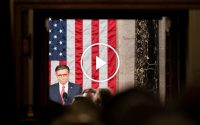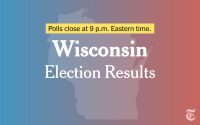What Past Polling Misses Can Tell Us About the 2024 Election
If there’s one thing you remember about the 2016 election polls, it’s probably that they were wrong — very wrong. Right?
It’s true that pollsters that year underestimated Donald J. Trump’s support in key swing states. But the national polls, on average, aligned pretty closely with the popular vote, which Hillary Clinton won. In fact, the national polls in 2020 were worse, but since they correctly showed Joseph R. Biden Jr. in the lead, and he won the election, the gap was not as memorable.
A look at polling averages over time shows that the last two cycles were not outside the scope of previous elections. But this year, amid another tight presidential race, even a small polling miss could vastly misjudge the outcome.
National polling misses in presidential elections
Note: Arrows show the weighted national polling average margin compared with the final national popular vote margin.
Every cycle, the polls diverge from the election results to some extent. It’s inevitable when pollsters can only make estimates about who will show up to vote, some people only make up their minds in the voting booth, and bombshells may drop late in the race.
Data from the past four decades shows that the polls do not always bias one party over the other, and that past performance can’t predict how the polls will do the next time around. The polls in the 2022 midterms, for example, were some of the most accurate in years.
To judge the accuracy of presidential polls, the charts in this article show averages that combine many polls into one estimate for each election. Between 1988 and 2020, the final national polling average was off by an average of 2.3 percentage points.
Some years were better than others: In 2008, the national polling average missed the final result for Barack Obama by less than one percentage point on average; in 1996, it overestimated the support for Bill Clinton by almost four points.
State-level polls haven’t performed quite as well. Since 2000, polls in close states have been off by an average of 3.1 points. In 2016 and 2020, nearly all of the state-level polling averages underestimated support for Mr. Trump, sometimes by a wide margin.
State polling misses in presidential elections with Trump
Wisconsin had one of the biggest polling misses in recent cycles, overstating Mr. Biden’s support by 9 points.
Several states that Mr. Trump ultimately won had polling averages showing Ms. Clinton in the lead.
The state polling misses have been magnified in the last two presidential elections — two very close races that heightened the importance of the Electoral College. But the polls’ performance in those two years was not entirely unusual. A look at state polling misses since 2000 shows that polls of older elections did about as well as today’s polls.
State polling misses in presidential elections
State polls underestimated Mr. Obama, with the exception of South Carolina, which Mitt Romney won.
Polls showed John McCain leading in Indiana, but Mr. Obama won the state.
Polls were more of a mixed bag, with some underestimating George W. Bush, and others John Kerry.
Al Gore won the popular vote but lost the election. Polls showed Mr. Bush leading in Florida, but the results were razor thin.
State polls have missed in both directions over the years. But if pollsters underestimated Mr. Trump in the last two elections, are they doomed to do so again this year? Should you, as some poll watchers claim to do, mentally add a boost for Mr. Trump to any poll numbers you see?
Pollsters believe they have largely identified what caused the polling misses in 2016. A major culprit was the failure to account for voters’ education levels, according to a report from a professional organization of public pollsters. State level polls in particular that year overrepresented college-educated respondents and undercounted respondents without a college degree.
This was less of a problem in past elections, when vote choice did not cleave so sharply along educational lines. But in 2016 and thereafter, non-college-educated voters have largely supported Republicans, especially Mr. Trump.
By 2020, nearly all pollsters had begun accounting for education. But polls still underestimated Mr. Trump. This time, the cause of the error was less clear-cut. One theory, presented by a report evaluating 2020 polls, is that Trump supporters were less likely to respond to surveys. As a result, “even if you control for white non-college male, the ones that answer the survey are more Democratic than the ones who don’t,” said Chris Jackson, who heads U.S. public opinion research for Ipsos. Others have posited that Biden voters were more likely to stay at home during the pandemic, giving them more time and opportunity to respond to polls.
Yet another challenge that year: the record turnout. About a quarter of voters in 2020 had not voted in 2016, according to estimates by the Pew Research Center. And polling had indicated that any new 2020 voters would mostly be Biden supporters. In fact, they were divided between Mr. Biden and Mr. Trump, according to the Pew study.
So, what about this year? Polling in seven swing states is extremely close — in most of these states, Mr. Trump and Kamala Harris are essentially tied. While the polls in these states underestimated Mr. Trump’s support in the last two cycles, historically, they have a mixed track record, with misses on both the left and right, and some years better than others.
Past polling misses in presidential elections for battleground states
Years in bold indicate those in which the polling leader lost in that state.
Note: Averages not available for some states in some years.
Most pollsters have made some changes to their methodology, partly in response to the 2020 misses, and the accurate 2022 midterm polls gave pollsters some optimism.
But one key difference between the midterms and the last two presidential elections is that Mr. Trump was not on the ballot. Ultimately, there may be something about Mr. Trump’s supporters that makes them especially difficult to measure in polls.
“There’s a real possibility that having Trump on the ballot makes it hard to poll for whatever reason,” said Berwood Yost, the director of the Franklin & Marshall College Poll of Pennsylvania.
“But the other possibility is that we’ve made all these adjustments to correct the error. And perhaps we’ve overcorrected,” he added. “I don’t know which it is.”


